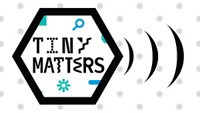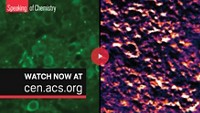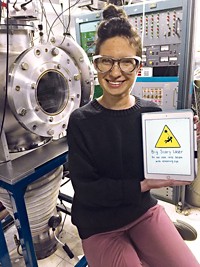Advertisement
Grab your lab coat. Let's get started
Welcome!
Welcome!
Create an account below to get 6 C&EN articles per month, receive newsletters and more - all free.
It seems this is your first time logging in online. Please enter the following information to continue.
As an ACS member you automatically get access to this site. All we need is few more details to create your reading experience.
Not you? Sign in with a different account.
Not you? Sign in with a different account.
ERROR 1
ERROR 1
ERROR 2
ERROR 2
ERROR 2
ERROR 2
ERROR 2
Password and Confirm password must match.
If you have an ACS member number, please enter it here so we can link this account to your membership. (optional)
ERROR 2
ACS values your privacy. By submitting your information, you are gaining access to C&EN and subscribing to our weekly newsletter. We use the information you provide to make your reading experience better, and we will never sell your data to third party members.
People
Movers And Shakers
C&EN talks with Joanna Fowler, radiochemistry pioneer
The retired Brookhaven chemist looks back on her career developing radiotracers for brain imaging
by Louisa Dalton, special to C&EN
June 20, 2016
| A version of this story appeared in
Volume 94, Issue 25

It’s been 40 years since Joanna S. Fowler helped develop 18F-fluorodeoxyglucose (18F-FDG), now the most common radiotracer for imaging cancer with positron emission tomography. It’s also widely used to study brain function and glucose metabolism. Over her career, Fowler has designed many other radiotracers and used them to illuminate pathways in the brain, particularly the addicted brain. Fowler, who retired from Brookhaven National Laboratory two years ago, spoke with Louisa Dalton about what drew her to the field.
What was it like to start your career in the group at Brookhaven that developed 18F-FDG?
Vitals
Hometown: Miami
Studies: B.A., University of South Florida, 1964; Ph.D., University of Colorado, 1967
Professional highlights: University of East Anglia, postdoc; Brookhaven National Lab, 1969–2014; National Medal of Science, 2009; National Academy of Sciences, elected 2004; Holds eight patents for radiotracers
Favorite molecule: 18F-fluorodeoxyglucose, of course
Post-retirement: Living in Norfolk, Va. Working with former colleagues as a volunteer at NIH’s Laboratory of Neuroimaging
This was really exciting for me because this was my first real job. I was a young organic chemist in the group of Al Wolf, who was what they called a hot-atom chemist. He had gotten very excited about actually being able to incorporate very short-lived isotopes like carbon-11 and fluorine-18 into organic compounds and use them to trace biological processes in living systems.
Two other groups, at the National Institutes of Health and the University of Pennsylvania, had developed a new method for looking at brain glucose metabolism in animals using 2-deoxyglucose labeled with carbon-14. But the decay energy of carbon-14—an isotope now often used for archaeological dating—is too weak to be detected outside the body. They contacted Al and his group and brainstormed with us to see if we could figure out how to put an appropriate isotope on a sugar molecule to extend this new method to human studies.
It was a big challenge because they had the camera and medical facility in Philadelphia. We would have to put some kind of short-lived isotope on 2-deoxyglucose on Long Island and then transport it to Philadelphia with enough radioactivity left to do scanning. We had to consider not only synthetic chemistry and radiochemistry, but also biochemistry. 2-Deoxyglucose is a simple little molecule. We had to figure out how many changes we could make on it without affecting its biochemistry.
You worked for many years illuminating the addicted brain. Why addiction?
In the late ’80s, I had a collaborator, Nora Volkow. She was just driven to study addiction. It rubbed off on me. Now, I don’t think there is any disease that is more important. The two major killers, lung disease and heart disease, are directly related to smoking, which is a disease of the brain, which is addiction. And then you look at AIDS, and violence, and anything related to alcoholism and smoking, and now heroin addiction. I think you can make a really, really strong case that there isn’t anything that spills over and causes more social and medical and economic problems than addiction.
Tell me something you discovered about addiction.
Nora and I were interested in what makes cocaine so powerfully addictive. We put a carbon-11 on the cocaine molecule so we could track it in the human brain.
We got permission to give it to cocaine abusers in a pharmacological dose and track the high. We learned cocaine gets into the brain extremely rapidly, and a whole lot gets in. It also leaves very rapidly. The presence of cocaine in the brain almost perfectly parallels the intense high. The high peaks at about five to 10 min, but after half an hour, the high is gone, and the drug is gone. So the person takes the cocaine again in a bingelike pattern until the supply is gone.
Then we compared another stimulant drug given to kids for attention-deficit disorder: methylphenidate, or Ritalin. It is pharmacologically almost identical to cocaine. They both bind to the dopamine transporter and to the norepinephrine transporter in the brain.
Why does Ritalin have therapeutic effects? If you give it intravenously, it also gets to the brain rapidly and gives a very intense high, though cocaine abusers don’t like it as much because it stays too long. But if you give it orally, it gets to the brain very slowly. It’s not a surge of dopamine—it’s a slow release. When you have a slow release of dopamine, that allows a person to focus attention. The rate at which it hits the brain causes two different behavioral responses.
What is the major chemical challenge in designing useful radiotracers?
I would say bioavailability of molecules. You put a whole lot of effort into designing a molecule that will bind to an enzyme or a receptor or transporter. But once you introduce it to the bloodstream, all bets are off. The major challenge is to have it survive metabolism and transport in the body. I think it is an underappreciated problem.
What motivated you to stay at Brookhaven for most of your career?
I was always driven by being able to work on interesting problems and being able to see them through. I follow my heart. I grab hold of a problem, and I don’t let go. Wherever we needed to go, whatever the next question was, we were able to do it.
It was a place that inspired people to tackle big problems, and an environment where people worked together on problems in a really collegial way. I think a lot about how to foster such an environment. It’s not easy to achieve, but in the end, it’s bringing people together that helps ideas flourish.
Louisa Dalton is a freelancer. This interview first appeared in ACS Central Science: cenm.ag/fowler. It has been edited for length and clarity.





Join the conversation
Contact the reporter
Submit a Letter to the Editor for publication
Engage with us on Twitter